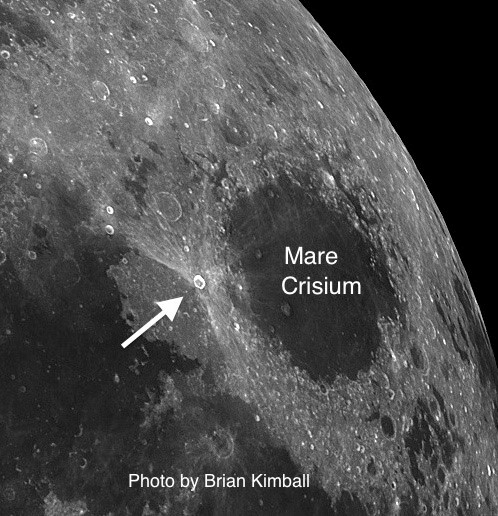 The week of December 4 – 10 takes us from Day 16 to the end of Day 23. This week we will highlight the craters Proclus, viewable on Tuesday evening, and Moltke, viewable after 11:00 PM Thursday night.
The week of December 4 – 10 takes us from Day 16 to the end of Day 23. This week we will highlight the craters Proclus, viewable on Tuesday evening, and Moltke, viewable after 11:00 PM Thursday night.
 Proclus: [NE/H14] Proclus is a small crater located just west of Mare Crisium. In spite of its size it is one of the brightest spots on the Moon. When you view it around full moon you will notice it also has a system of rays that delicately fan out in a telltale butterfly-wing pattern, which tells you a lot about the flight path of the incoming projectile. Proclus is one of the best examples of what happens during a low-angle impact.
Proclus: [NE/H14] Proclus is a small crater located just west of Mare Crisium. In spite of its size it is one of the brightest spots on the Moon. When you view it around full moon you will notice it also has a system of rays that delicately fan out in a telltale butterfly-wing pattern, which tells you a lot about the flight path of the incoming projectile. Proclus is one of the best examples of what happens during a low-angle impact.
Moltke: [NE/K12] Just south of the Apollo 11 site is Moltke (4 miles in diameter—about 4 arc-seconds), a perfect example of a simple crater.
There are more simple craters on the Moon than any other type. They are usually less than ten miles in diameter. Simple craters start out with the shape of a round bowl with smooth, circular rims. However, some of them develop flat floors resulting from a cascade of boulders which have rolled down the interior walls and settled at the bottom.
With patience, good lighting and decent optics, you should be able to tell if a simple crater has a flat or rounded floor by looking at the shadow of the rim as it crosses the center of the floor. The shadow on a bowl-shaped floor will appear as a smooth arc; the shadow falling across a flat floor will be truncated (i.e., the apex will be squared off).1
1 Simple craters are also useful objects for testing both the quality of your optics and the seeing conditions. Sky & Telescope’s Field Map of the Moon conveniently lists the diameters of all craters. Look for craters that are less than 9 mi. in diameter.
======================
It is highly recommended that you get a copy of Sky and Telescope’s Field Map of the Moon, the very finest Moon map available for use at the telescope. It is available for $10.95 at www.skyandtelescope.com and on Amazon. All features mentioned in this blog will be keyed to the grid on the Field Map and will look like this: Plato: [NW/D9]
Credits:
Courtesy of Gray Photography of Corpus Christi, Texas
Lunar photos: NASA / USGS / BMDO / LROC / ASU / DLR / LOLA / Moon Globe. Used by permission
- Rupes Cauchy: A Best Known Fault on the Moon - July 22, 2024
- Moon Crater Schickard – Crater Floor has Stripes - July 15, 2024
- Moon Craters Langrenus and Vandelinus - July 8, 2024